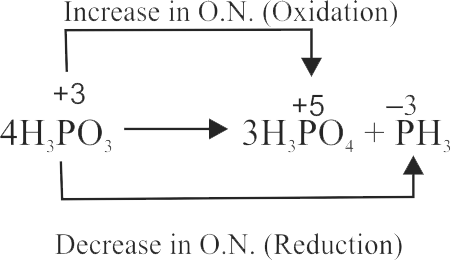315157
Among the following, what is the total number of compounds having +3 oxidation state of the underlined elements?
\(({\rm{a}}){\mkern 1mu} {{\rm{K}}_{\rm{4}}}\underline {{{\rm{P}}_{\rm{2}}}{{\rm{O}}_7}} \)
\({\text{(b)Na}}{\mkern 1mu} \underline {{\text{Au}}} {\mkern 1mu} {\text{C}}{{\text{l}}_{\text{4}}}\,\,{\mkern 1mu} \)
\({\text{(c)R}}{{\text{b}}_{\text{4}}}{\text{Na}}\left[ {{\text{H}}\underline {{{\text{V}}_{{\text{10}}}}} {{\text{O}}_{{\text{28}}}}} \right]\,\,\)
\({\text{(d)}}\underline {\text{I}} {\text{Cl}}{\mkern 1mu} {\mkern 1mu} {\mkern 1mu} {\mkern 1mu} {\mkern 1mu} {\mkern 1mu} \,\,\,\,\)
\(\,{\text{(e)B}}{{\text{a}}_{\text{2}}}\underline {{\text{Xe}}} {{\text{O}}_{\text{6}}}{\mkern 1mu} {\mkern 1mu} {\mkern 1mu} {\mkern 1mu} \)
\({\mkern 1mu} {\text{(f)}}\underline {\text{O}} {{\text{F}}_{\text{2}}}\,\,\,\,\,\)
\({\rm{(g)Ca}}{\left( {\underline {{\rm{Cl}}{{\rm{O}}_{\rm{2}}}} } \right)_{\rm{2}}}\)
\({\rm{(h)}}\underline {\rm{N}} {\rm{O}}_2^ - \)
315157
Among the following, what is the total number of compounds having +3 oxidation state of the underlined elements?
\(({\rm{a}}){\mkern 1mu} {{\rm{K}}_{\rm{4}}}\underline {{{\rm{P}}_{\rm{2}}}{{\rm{O}}_7}} \)
\({\text{(b)Na}}{\mkern 1mu} \underline {{\text{Au}}} {\mkern 1mu} {\text{C}}{{\text{l}}_{\text{4}}}\,\,{\mkern 1mu} \)
\({\text{(c)R}}{{\text{b}}_{\text{4}}}{\text{Na}}\left[ {{\text{H}}\underline {{{\text{V}}_{{\text{10}}}}} {{\text{O}}_{{\text{28}}}}} \right]\,\,\)
\({\text{(d)}}\underline {\text{I}} {\text{Cl}}{\mkern 1mu} {\mkern 1mu} {\mkern 1mu} {\mkern 1mu} {\mkern 1mu} {\mkern 1mu} \,\,\,\,\)
\(\,{\text{(e)B}}{{\text{a}}_{\text{2}}}\underline {{\text{Xe}}} {{\text{O}}_{\text{6}}}{\mkern 1mu} {\mkern 1mu} {\mkern 1mu} {\mkern 1mu} \)
\({\mkern 1mu} {\text{(f)}}\underline {\text{O}} {{\text{F}}_{\text{2}}}\,\,\,\,\,\)
\({\rm{(g)Ca}}{\left( {\underline {{\rm{Cl}}{{\rm{O}}_{\rm{2}}}} } \right)_{\rm{2}}}\)
\({\rm{(h)}}\underline {\rm{N}} {\rm{O}}_2^ - \)
315157
Among the following, what is the total number of compounds having +3 oxidation state of the underlined elements?
\(({\rm{a}}){\mkern 1mu} {{\rm{K}}_{\rm{4}}}\underline {{{\rm{P}}_{\rm{2}}}{{\rm{O}}_7}} \)
\({\text{(b)Na}}{\mkern 1mu} \underline {{\text{Au}}} {\mkern 1mu} {\text{C}}{{\text{l}}_{\text{4}}}\,\,{\mkern 1mu} \)
\({\text{(c)R}}{{\text{b}}_{\text{4}}}{\text{Na}}\left[ {{\text{H}}\underline {{{\text{V}}_{{\text{10}}}}} {{\text{O}}_{{\text{28}}}}} \right]\,\,\)
\({\text{(d)}}\underline {\text{I}} {\text{Cl}}{\mkern 1mu} {\mkern 1mu} {\mkern 1mu} {\mkern 1mu} {\mkern 1mu} {\mkern 1mu} \,\,\,\,\)
\(\,{\text{(e)B}}{{\text{a}}_{\text{2}}}\underline {{\text{Xe}}} {{\text{O}}_{\text{6}}}{\mkern 1mu} {\mkern 1mu} {\mkern 1mu} {\mkern 1mu} \)
\({\mkern 1mu} {\text{(f)}}\underline {\text{O}} {{\text{F}}_{\text{2}}}\,\,\,\,\,\)
\({\rm{(g)Ca}}{\left( {\underline {{\rm{Cl}}{{\rm{O}}_{\rm{2}}}} } \right)_{\rm{2}}}\)
\({\rm{(h)}}\underline {\rm{N}} {\rm{O}}_2^ - \)
315157
Among the following, what is the total number of compounds having +3 oxidation state of the underlined elements?
\(({\rm{a}}){\mkern 1mu} {{\rm{K}}_{\rm{4}}}\underline {{{\rm{P}}_{\rm{2}}}{{\rm{O}}_7}} \)
\({\text{(b)Na}}{\mkern 1mu} \underline {{\text{Au}}} {\mkern 1mu} {\text{C}}{{\text{l}}_{\text{4}}}\,\,{\mkern 1mu} \)
\({\text{(c)R}}{{\text{b}}_{\text{4}}}{\text{Na}}\left[ {{\text{H}}\underline {{{\text{V}}_{{\text{10}}}}} {{\text{O}}_{{\text{28}}}}} \right]\,\,\)
\({\text{(d)}}\underline {\text{I}} {\text{Cl}}{\mkern 1mu} {\mkern 1mu} {\mkern 1mu} {\mkern 1mu} {\mkern 1mu} {\mkern 1mu} \,\,\,\,\)
\(\,{\text{(e)B}}{{\text{a}}_{\text{2}}}\underline {{\text{Xe}}} {{\text{O}}_{\text{6}}}{\mkern 1mu} {\mkern 1mu} {\mkern 1mu} {\mkern 1mu} \)
\({\mkern 1mu} {\text{(f)}}\underline {\text{O}} {{\text{F}}_{\text{2}}}\,\,\,\,\,\)
\({\rm{(g)Ca}}{\left( {\underline {{\rm{Cl}}{{\rm{O}}_{\rm{2}}}} } \right)_{\rm{2}}}\)
\({\rm{(h)}}\underline {\rm{N}} {\rm{O}}_2^ - \)
315157
Among the following, what is the total number of compounds having +3 oxidation state of the underlined elements?
\(({\rm{a}}){\mkern 1mu} {{\rm{K}}_{\rm{4}}}\underline {{{\rm{P}}_{\rm{2}}}{{\rm{O}}_7}} \)
\({\text{(b)Na}}{\mkern 1mu} \underline {{\text{Au}}} {\mkern 1mu} {\text{C}}{{\text{l}}_{\text{4}}}\,\,{\mkern 1mu} \)
\({\text{(c)R}}{{\text{b}}_{\text{4}}}{\text{Na}}\left[ {{\text{H}}\underline {{{\text{V}}_{{\text{10}}}}} {{\text{O}}_{{\text{28}}}}} \right]\,\,\)
\({\text{(d)}}\underline {\text{I}} {\text{Cl}}{\mkern 1mu} {\mkern 1mu} {\mkern 1mu} {\mkern 1mu} {\mkern 1mu} {\mkern 1mu} \,\,\,\,\)
\(\,{\text{(e)B}}{{\text{a}}_{\text{2}}}\underline {{\text{Xe}}} {{\text{O}}_{\text{6}}}{\mkern 1mu} {\mkern 1mu} {\mkern 1mu} {\mkern 1mu} \)
\({\mkern 1mu} {\text{(f)}}\underline {\text{O}} {{\text{F}}_{\text{2}}}\,\,\,\,\,\)
\({\rm{(g)Ca}}{\left( {\underline {{\rm{Cl}}{{\rm{O}}_{\rm{2}}}} } \right)_{\rm{2}}}\)
\({\rm{(h)}}\underline {\rm{N}} {\rm{O}}_2^ - \)

